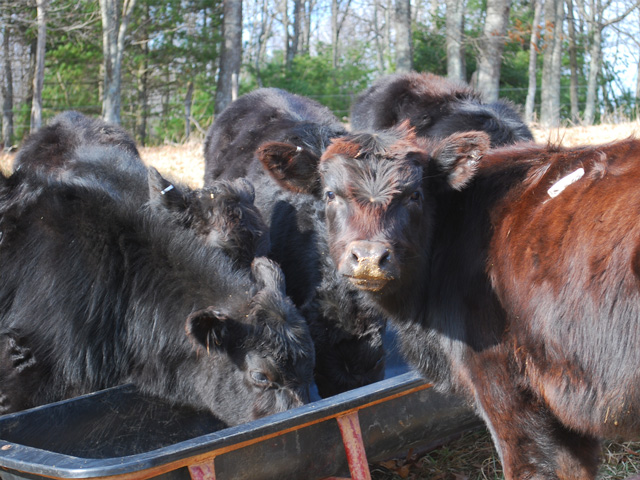Shipping Fever
Respiratory Disease Losses Mount for the Cattle Industry
Dan Stafford, a veterinarian and feed-yard and stocker consultant in south-central Texas, knows there are ways to beat Bovine Respiratory Disease (BRD). He's seen success firsthand with a feed-yard client who struggled with the issue for 10 years.
"It was getting to where they couldn't bear it anymore, so they tried two approaches," recalled Stafford. "First, they sought out and bought more cattle from a determined origin. The animals were not commingled and were not run through a sale barn. These animals came in less stressed and had a vaccination history.
"Second, they reduced the number of cattle that they were willing to take in at any one time, especially during the big fall runs. The manager always said, 'I can control BRD. All I have to do is close the front gate.' So, they went from processing 800 new animals a week to 250. They were no longer overloading their system, and they saw incredible results. The cowboy crew could finally catch their breath, and they were able to do a better job. That operation wound up making more money. They saved eight- to 10-fold on medicine, and they had a significant reduction in mortality and morbidity."
Part of their successful shift was also due to renewed efforts in the art of animal husbandry. It all came together in a very positive way.
"We need to put ourselves in the situation of the animal," noted Stafford. "What do you want? You want clean water, something good to eat, protection from the elements, and to be comfortable. Good animal husbandry is about focusing on those basics, while leveraging the antibiotics we have available. That's what's really going to save us on BRD costs in the long run."
BRD, known commonly as shipping fever, is estimated to cost the cattle industry up to $900 million annually. What does that number really mean to producers?
"It's hard for me to appreciate $900 million worth of losses spread out across the whole industry," said Mike Nichols, veterinarian with Boehringer Ingelheim (BI). "But it's a cost that impacts every operation. It hits profitability, competitiveness and sustainability."
P[L1] D[0x0] M[300x250] OOP[F] ADUNIT[] T[]
Stafford agreed, and added it is the No. 1 cause of disease for the stockers and feed-yards he works with.
"It's almost impossible to put a number to how each animal is impacted adversely," Stafford said. "Initially, when producers think about costs associated with BRD, they think about up-front, tangible losses like mortality or how much it costs to give antibiotics. But that's just the tip of the iceberg."
The veterinarian said the most common complaint he hears from clients about BRD is that while the industry has more expensive, new-and-improved antibiotics they seem to be yielding the same results.
"I try to remind producers that to manage the cost of antibiotics and BRD, we need to make sure that we've got a well-thought-out treatment protocol in place," explained Stafford.
Nichols agreed, and noted an antibiotic should protect against all four BRD-causing pathogens: Mannheimia haemolytica, Pasteurella multocida, Histophilus somni and Mycoplasma bovis.
Managing treatment costs is easier if producers recognize early signs of BRD and treat accordingly. Stafford said it's important to find the specific cause of BRD, in other words what pathogen is causing the illness. This helps insure the best vaccination and treatment protocols are used. Once it's clear an antibiotic is needed, Stafford advised use of a long-last, fast-acting antibiotic. And he stressed to absolutely follow the label.
"If the product label states it is effective for 10 days, we need to refrain from re-treating too quickly and give the animal sufficient time to respond to the antibiotic," he said. "Giving another dose in that situation increases cost without increasing effectiveness."
There's no way to know if a program is working without records to track the animal, its health issues, and treatments and products used. Those records should be available for the herd vet to evaluate, which will help focus and improve treatment.
PREVENTION IS BETTER
While treatment is often a necessity, prevention should always be the goal.
Stafford said an unknown vaccination history is the biggest obstacle feed-yard producers face when dealing with BRD today.
"Ideally, my clients wouldn't buy an animal unless it already had at least one round, if not two rounds, of vaccinations," he said. "My dream scenario would be for them to buy cattle that are vaccinated once at branding, and again at weaning before shipment. Then, when cattle arrive at the feed-yard, they'd get a booster. If all my producers did that, it might put me out of work."
BI's Nichols added optimizing nutrition programs is also important to make sure the immune system is functioning well and is able to prevent disease. This includes providing plenty of fresh, clean water with that balanced ration.
Lastly, stress management is extremely important when it comes to BRD. It's been known for years that stress compromises an animal's immune system and makes it more susceptible to disease.
"I think we've made very efficient systems for handling and moving cattle, but as we've done that, we've put extra stress on animals," remarked Stafford. "Cattle are now expected to move hundreds of miles in the blink of an eye, meet new pen mates and face all the other stressors that go along with moving."
Producers can offset some of that stress with simple steps, including: shielding cattle from harsh weather conditions, giving them plenty of bunk space; avoiding overcrowding; practicing low-stress handling; and where appropriate administering a metaphylaxis treatment, or a group antibiotic treatment, for at-risk animals in a timely manner to help reduce morbidity and mortality.
(c) Copyright 2020 DTN, LLC. All rights reserved.





